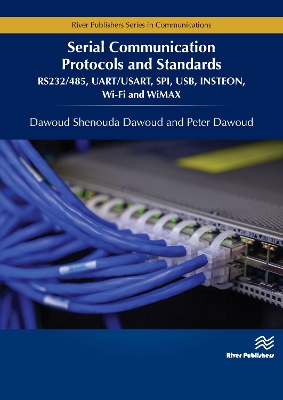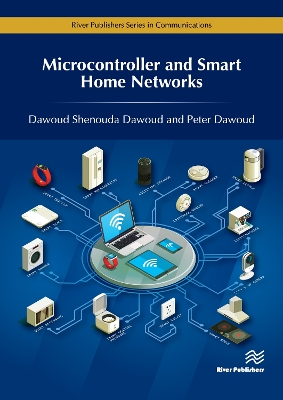River Publishers Series in Communications
2 total works
Serial Communication Protocols and Standards
by Dawoud Shenouda Dawoud and Peter Dawoud
Published 30 April 2020
Data communication standards are comprised of two components: The "protocol" and "Signal/data/port specifications for the devices involved". The protocol describes the format of the message and the meaning of each part of the message. To connect any device to the bus, an external device must be used as an interface which will put the message in a form which fulfills all the electrical specifications of the port. These specifications are called the "Standard". The most famous such serial communication standard is the RS-232.
In IT technology, Communication can be serial or parallel. Serial communication is used for transmitting data over long distances. It is much cheaper to run the single core cable needed for serial communication over a long distance than the multicore cables that would be needed for parallel communication. It is the same in wireless communication: Serial communication needs one channel while parallel needs multichannel. Serial Communication can also be classified in many other ways, for example synchronous and asynchronous; it can also be classified as simplex, duplex and half duplex.
Because of the wide spread of serial communication from home automation to sensor and controller networks, there is a need for a very large number of serial communication standards and protocols. These have been developed over recent decades and range from the simple to the highly complicated. This large number of protocols was necessary to guarantee the optimum performance for the targeted applications. It is important for communication engineers to have enough knowledge to match the right protocol and standard with the right application. The main aim of this book is to provide the reader with that knowledge.
The book also provides the reader with detailed information about:Serial CommunicationUniversal Asynchronous Receiver Transmitter (UART)Universal Synchronous/Asynchronous Receiver Transmitter (USART)Serial Peripheral Interface (SPI) eSPIUniversal Serial Bus (USB)Wi-FiWiMaxInsteonThe details of each technology including specification, operation, security related matters, and many other topics are covered.
The book allocates three chapters to the main communication standards. These chapters cover everything related to the most famous standard RS-232 and all its variants.
Other protocols such as: I2C, CAN, ZigBee, Z-Wave, Bluetooth, and others, are the subject of the authors separate book "Microcontroller and Smart Home Networks".
In IT technology, Communication can be serial or parallel. Serial communication is used for transmitting data over long distances. It is much cheaper to run the single core cable needed for serial communication over a long distance than the multicore cables that would be needed for parallel communication. It is the same in wireless communication: Serial communication needs one channel while parallel needs multichannel. Serial Communication can also be classified in many other ways, for example synchronous and asynchronous; it can also be classified as simplex, duplex and half duplex.
Because of the wide spread of serial communication from home automation to sensor and controller networks, there is a need for a very large number of serial communication standards and protocols. These have been developed over recent decades and range from the simple to the highly complicated. This large number of protocols was necessary to guarantee the optimum performance for the targeted applications. It is important for communication engineers to have enough knowledge to match the right protocol and standard with the right application. The main aim of this book is to provide the reader with that knowledge.
The book also provides the reader with detailed information about:Serial CommunicationUniversal Asynchronous Receiver Transmitter (UART)Universal Synchronous/Asynchronous Receiver Transmitter (USART)Serial Peripheral Interface (SPI) eSPIUniversal Serial Bus (USB)Wi-FiWiMaxInsteonThe details of each technology including specification, operation, security related matters, and many other topics are covered.
The book allocates three chapters to the main communication standards. These chapters cover everything related to the most famous standard RS-232 and all its variants.
Other protocols such as: I2C, CAN, ZigBee, Z-Wave, Bluetooth, and others, are the subject of the authors separate book "Microcontroller and Smart Home Networks".
Microcontroller and Smart Home Networks
by Dawoud Shenouda Dawoud and Peter Dawoud
Published 30 April 2020
Over recent years industries have faced the problem of how to connect devices to 'speak' to each other with minimum wiring. Philips Semiconductors faced this problem when they needed to connect many ICs together. The Automotive Industry faced the same problem when it needed to connect tens of microcontrollers in each car. Recently, with smart homes, the problem has started to be part of each home. For instance, you may want to build your smart home with accessories from different manufacturers and you want the devices to 'speak' to each other. Added to that, you may want to control them from a central App or voice assist.
Solutions for this problem started with the introduction of Inter Integrated Circuits (IIC) and Controller Area Networks (CAN). Both solutions are wired networks that allow ICs and microcontrollers to be connected in a network to communicate together.
In smart home automation, a number of common smart home automation protocols that allow different devices to speak and communicate together have appeared during the last few decades. Some of the smart home protocols come under the umbrella of what is called the "Internet of Things (IoT)". The proposed protocols can be grouped into wired networks e.g. X10, UPB; wireless or radio networks as ZigBee, Z-Wave, Bluetooth; or dual (wired and radio) such as Insteon.
This book introduces to the reader some of the most popular Microcontroller and Smart home networks. The book covers in detail the following protocols:I2CI3CCANZigBeeZigBee ProZ-WaveBluetoothWi-Fi, WiMax and Insteon are part of our companion book Serial Communication Protocols and Standards.
This book gives detailed comparisons between the various protocols. To complete the knowledge of the reader, the book gives in the last chapter a short summary on the protocols that we did not fully cover in this volume: Ethernet, Thread, Insteon, X10 and UPB.
Solutions for this problem started with the introduction of Inter Integrated Circuits (IIC) and Controller Area Networks (CAN). Both solutions are wired networks that allow ICs and microcontrollers to be connected in a network to communicate together.
In smart home automation, a number of common smart home automation protocols that allow different devices to speak and communicate together have appeared during the last few decades. Some of the smart home protocols come under the umbrella of what is called the "Internet of Things (IoT)". The proposed protocols can be grouped into wired networks e.g. X10, UPB; wireless or radio networks as ZigBee, Z-Wave, Bluetooth; or dual (wired and radio) such as Insteon.
This book introduces to the reader some of the most popular Microcontroller and Smart home networks. The book covers in detail the following protocols:I2CI3CCANZigBeeZigBee ProZ-WaveBluetoothWi-Fi, WiMax and Insteon are part of our companion book Serial Communication Protocols and Standards.
This book gives detailed comparisons between the various protocols. To complete the knowledge of the reader, the book gives in the last chapter a short summary on the protocols that we did not fully cover in this volume: Ethernet, Thread, Insteon, X10 and UPB.

